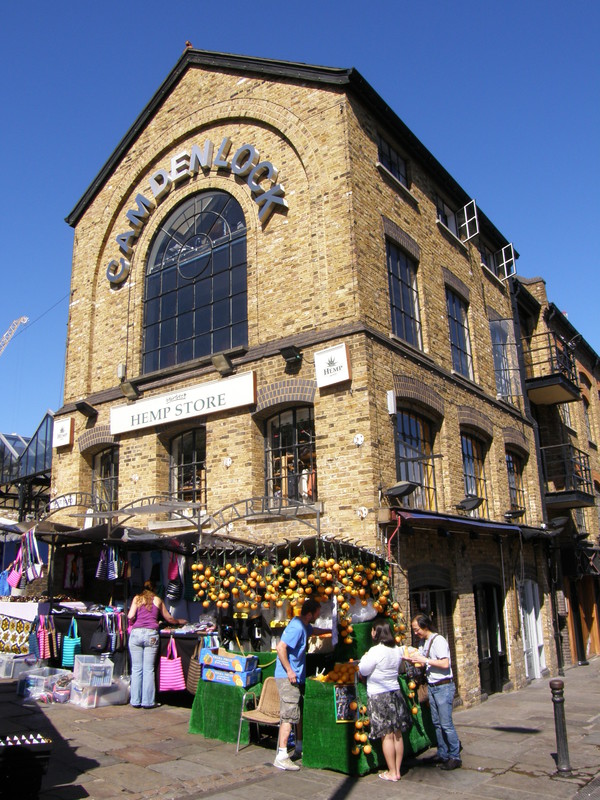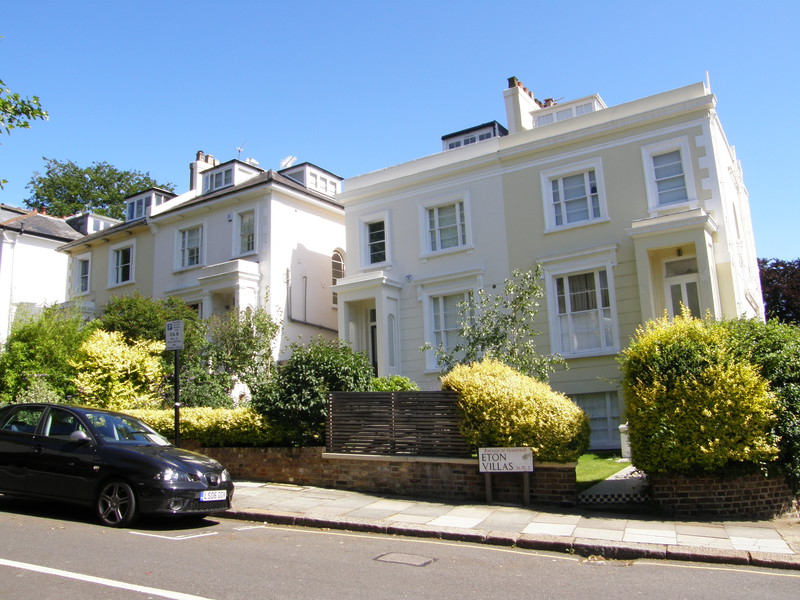
There's something slightly parable-esque about the route of this walk. It starts off with the abandon of youth in carefree Camden Town and rises to the top of the pile in Hampstead, before being brought down to earth by police action around Colinwood and left to go to seed in Burnt Oak and Edgware. I'm sure Simon Mann, the old Etonian who's just been slammed into an Equatorial Guinean jail for a failed coup, would appreciate the metaphorical aspects of the journey.
I was lucky enough to be joined by my friend Struan, with whom I shared nine months of enjoyable mayhem at my last employer. Good company always enhances a walk, and it's particularly rewarding when the sun is shining in a clear blue sky and there's no prospect of rain. My only regret is that when we finally decided we'd covered enough miles to warrant a rewarding pint in the sun, the supply of good pubs dried up completely... so if you're considering this walk and fancy a pint en route, make sure you get it in before you cross the M1, because if there's a line in the sand, that's definitely it.
Camden Town to Chalk Farm

Camden Town is a town of two halves. When I walked along the High Barnet branch with Bill the other day, we struck north along Kentish Town Road, where the theme was social housing, and lots of it. Sure, it was pretty good social housing and I'm sure a fairly hefty proportion of it is private these days, but it really doesn't compare to the part of Camden that lies along Chalk Farm Road, which is exquisite.
We started off with a detour along Inverness Street so I could pay homage to The Good Mixer pub, where I used to go every lunch time when I worked around the corner in Bayham Street. I'd head off via the Tube station with our art editor Tony, where we'd pick up Melody Maker (me) and the NME (Tony) before heading to the Mixer to sink two or three pints and play pool before sloping back for an afternoon of writing and snoozing back in the office. Back then the Mixer was a renowned Camden landmark and would regularly crop up in the pages of the music papers, as Food Records was round the corner and all sorts of famous people would crop up there. I have no idea whether it's still the case, and I'm too old to care, but it was fun to say hello again.

Just up the road is Camden Lock, which these days feels more like a canalside Covent Garden that the slightly risqué market it used to be. A Starbucks sits overlooking the lock and the boutiques are clean, fresh and tailored for the tourist onslaught, and although I'm sure there are plenty of purists who mourn the grittier days, I like the new cosmopolitan feel, particularly on a sunny day, when sitting by the canal, sipping on a latte and watching the world go by is an enjoyable way to spend a morning.
A little further on, Stables Market appears to have the builders in, so no doubt the cleansing operation continues apace, and a little further on, the Roundhouse has had the same treatment, and it now positively gleams by the roadside. A famous music venue, the Roundhouse was originally built in 1847 as a turntable engine shed for turning steam trains around, as steam engines couldn't reliably reverse and they had to be physically turned around at the end of the line. The tracks are long gone and its high ceiling makes it a popular place for kicking out the jams, a journey that started in 1966 with a gig featuring the Soft Machine and Pink Floyd to celebrate the launch of the underground newspaper International Times. It's had its ups and downs since, but following its redevelopment in 2006, it seems to be doing well.

Chalk Farm station is a wedge-shaped building a little further north, clad in the familiar Leslie Green ox-blood red terracotta tiles of the Charing Cross, Euston & Hampstead Railway. The narrow width of the wedge means that this station has the longest frontage of any Leslie Green station, with eight arched windows in a row, but more impressive to me is the fact that Madness were photographed in front of the station for the cover of their album Absolutely (they originally wanted to be photographed in front of Camden Town, but the traffic was just too crazy). The station was refurbished in 2005 and the terracotta has polished up nicely; it's now quite a sight, particularly when set against a deep blue sky without a cloud to be seen.
Chalk Farm to Belsize Park

The houses along the backstreets of Chalk Farm are delightful, particularly those along Eton Villas and Primrose Gardens. Any student pretensions left over from Camden Town are well and truly blown out of the water by now, as this is obviously an expensive area, with lovely detached houses and period terraces surrounding little greens with bright red telephone boxes.
It's a consistently pretty stroll to Belsize Park station back on the main street, and although it is a busy thoroughfare, Belsize Park has the space to cope. The pavements are huge round here, so much so that the restaurants spill out onto the street, with entire seating sections soaking up the rays like a pleasant continental town in the tourist season. Even with the likes of Tootsies and the Gourmet Burger Kitchen taking up a section of the pavement four tables deep, there's plenty of room left for everyone, and the result is luxurious after the cramped high streets you normally find in town. The station itself is tucked back from the street, and just to the south is a white domed building that hides the entrance to the deep-level shelter built underneath the station.
Belsize Park to Hampstead

After a short stroll along the main drag in Belsize Park, past some lovely mansion blocks and shops, it's time to head for some greenery. The western fringe of Hampstead Heath can be reached along Pond Street, past the Royal Free Hospital and across the London Overground on South End Road; Parliament Hill then heads northwest past some exquisite terraced housing and suddenly, bang, you're in meadowy grassland that stretches into the distance. Turn right and after a short climb you reach the summit, and there is London laid out before you, with Canary Wharf and the City on the left, and the BT Tower on the right. Under a pure blue sky, like the one we enjoyed this morning, it's a great view; this makes up for the grey rain that greeted me at the top of Primrose Hill all those miles ago, back on day one of my tubewalk.

You could spend a whole afternoon wandering around the scrubland of Hampstead Heath (and indeed, quite a few men do just that, but we'll come onto that later), but if you're following the Tube you've got to turn back west at some point, and there's no better place to head for than Hampstead Village, home to some of the most expensive housing on the planet. It's easy to see why, as the houses along Well Walk and Flask Walk are absolutely divine; this might be zone 2, but the atmosphere is definitely one of an English village, and a very picturesque one at that. Even the likes of Starbucks and McDonald's on the high street are inconspicuous, as all the shops have to conform to the Hampstead style guide, and that doesn't include garish logos or corporate clowns. It's a blessed relief after some high streets around town.
Hampstead station, another 1907 red terracotta Leslie Green creation, is notable for being the deepest Tube station on the network. As Hampstead Village is on a large hill, the platforms are some 192 ft below ground level, served by the deepest lift shaft on the network at 181 ft. Pray that you don't get stuck here in a power cut, as the emergency stairs have 300 steps; that would certainly sort the men from the boys.
Hampstead to Golders Green

The houses to the north of the station continue the delightful theme of the rest of Hampstead, and it's worth heading up Heath Street from the station so you can take the steps to the left up to Holly Mount; from here the streets wind round in a gentle fashion, each corner revealing yet another house to make the heart sing. It isn't until you reach Branch Hill that things start to calm down with a modern block to the left, but even the modern buildings are classy round here, with some very sympathetic curved balconies looking out towards the heath.
Just to the north the road swings left, but all sorts of paths lead into the trees ahead. This is the West Heath, a wooded section of the heath that is probably best known for its transient population of cruising gay men. We didn't see any suspicious activity – indeed, the only people we saw were mums dragging their toddlers by the hand – but there's so much cover here that to find anything untoward, you'd have to go looking for it, which is probably why this is such a popular cruising spot in the first place.

On the other side of the West Heath is Golders Hill Park, a manicured formal park with a small zoo and lots of rolling grassland that's perfect for a spot of lunch. It's a bit of a shock to pop out of the other end onto Finchley Road, where the traffic is constant and the noise a surprise after the gentle pace of life in Hampstead. On the way to the station, keep an eye out for the Shree Swaminarayan Temple, which is housed in an old church on Willesden Lane; it's good to see old churches finding new uses rather than being razed to the ground.
Golders Green station was originally the northern terminus of the Charing Cross, Euston & Hampstead Railway when it opened in 1907, and it stayed that way until the extension to Hendon Central opened in 1923. The modern building that replaced the original terminus is not terribly interesting, particularly when compared to the ox-blood red stations further south, and this is a busy part of town, with buses flooding in every few minutes and a hectic traffic junction right next door. It's amazing to think that when the Tube arrived 100 years ago, Golders Green was a rural hamlet with a handful of houses and around 300 inhabitants; things changed rapidly in the next few decades, and these days it's hard to picture Golders Green as a peaceful part of the countryside, as yet another double-decker screeches into the depot.
Golders Green to Brent Cross

The suburbia between Golders Green and Brent Cross is inevitably a step down from the village paradise of Hampstead, but it's still an enjoyable part of the capital to walk through. Heading out along the early 20th-century buildings of the high street, you pass a Greek Orthodox Cathedral along Golders Green Road, and the old library building, which is typical of the architecture round here: it all sprang up in the wake of the Tube line, and it's laid out a bit like Trumpton, with large period clocks on the public buildings and a functional but solid look to the street.
Further away from the station, the suburbs are fairly standard, with some crimes against taste (such as the appalling cladding on the King Solomon Hotel) and some faded but perfectly pleasant rows of semi-detached post-war houses. However it isn't far to Brent Cross station, and my first experience of another Tube station designer, Stanley Heaps. Heaps was Leslie Green's assistant, and following Green's death in 1908, Heaps became the architect for Underground Electric Railways Company Limited (the precursor to London Underground) and designed a number of stations on the Bakerloo line before designing the stations on the Northern line extension to Edgware. Brent Cross station has a stone column frontage with a red brick and tiled roof building behind, with the name of the station clearly written across the top of the colonnade. The idea was to design stations that would fit into the suburbs that would soon grow around them, though I'm not sure the columns quite manage to merge with the Mock Tudor. It does make for a distinctive design, though, and I like the stations from here to Edgware (at least, those that still have the original architecture intact).
Brent Cross to Hendon Central

I'd originally planned to cross the North Circular Road at the footbridge to the north of Heathfield Gardens, but when we arrived, we found that the bridge was fenced off with warnings that it was no longer safe and closed until further notice (not surprisingly, as the bridge part is now missing altogether). Instead the sign suggested we traipse east to cross at the Brent Street footbridge, where we joined the Capital Ring for a few blocks to Hendon Park.
Hendon Park is a pleasant though not terribly exciting grassy area that flanks the Tube line as it heads north, and Hendon Central station is to the northwest, across the tracks and overlooking a busy junction on the A41. The original Stanley Heaps building has been incorporated into an impressive office block, and here the colonnade works really well, giving the curved red brick and stone block a central focus. On the corner just over the road from the station is the impressive 1932 Art Deco-inspired Ambassador Cinema, now a Virgin Active gym, and together with the buildings on the other corners of the junction, it gives Hendon an impressive focal point, even if the traffic is a little crazy.
Hendon Central to Colindale

I'd originally planned a winding route through the backstreets of Hendon towards Colindale, and we started off well enough, but I was so impressed by the huge houses along Brampton Grove that I took us left instead of right, and ended up back on The Burroughs, just off the main A41. I'm glad I got it wrong, though, because there are some fantastic buildings along here that are much more interesting that yet more suburbia. The town hall (1901) and nearby library (1929) are impressive red brick and stone buildings, but even more interesting is the fire station (1914) with its tower and three red arched doorways. A little further up the road is the Hendon campus of Middlesex University, and the main building, which was built between 1937 and 1938 as the Technical Institute before being incorporated into the university, is suitably grand.
Just north off this road is Church End, a lovely little lane that houses the attractive Greyhound pub, and St Mary's Church, whose 50 ft tower pokes up above the roofs as if this was a quiet little village square in the middle of the countryside (which it once was, as there's been a church here since at least 1157). Sir Stamford Raffles, the founder of Singapore, is buried in the church graveyard, as is Herbert Chapman, the manager of Arsenal in the 1920s and 1930s.

This, however, is when the fun stops, because a little walk down the road is the M1, and on the other side things take a turn for the worse. Up to this point, this walk is delightful; from here to the end, it's rather less impressive, a change signalled by Hendon Police College, the Metropolitan Police's huge training centre to the west of the motorway. There's a new housing development opposite, but after the residential flavour of the walk up to this point, you suddenly feel as if you've been stranded in Nowheresville, as most of the buildings have the air of a large industrial estate, rather than anything approaching a home. There's the Police National Computer Data Centre, hidden away behind serious security, followed by Hendon Parade Ground where cadets pass out at the end of their training, and the theme is continued by packs of policemen cycling past on training exercises as the closed-circuit TV cameras look on. This is effectively Cop-land, and it feels like it.
Colindale station was originally opened in 1924 as the first station on the line's second extension (which took it to Edgware), but the station was destroyed by bombing in 1940 and none of the original Stanley Heaps building remains. A temporary wooden building was used until the current office block was built in 1962, and it's a pretty bland replacement, truth be told.
Colindale to Burnt Oak

It's not a pretty walk from Colindale to Burnt Oak, though there are a couple of worthy parks that make life more pleasant. The suburbs are rather worn around the edges and after the beauty of Hampstead it's sometimes a bit wearing, and as if to rub it in, the area to the west of the station is dominated by a staggering ugly office tower that looms over the industrial parks next to the main road. There's also the Health Protection Agency Centre for Infections, which is hardly the kind of place you want to live near, though on a more positive note, the British Library's newspaper collection lives in an impressive building near the station. However this isn't a particularly lovely part of town, and it's best to get through the suburbs quickly and up to Montrose Park for a little respite, a theme continued a little further north by Silk Stream Park. The Silk Stream flows through both parks, though it's a fairly typical urban stream at this point, a little choked by overgrowth and hidden away rather than celebrated.
Coming out onto Watling Avenue, take a moment to turn left to 9 Watling Avenue, the site of the first Tesco store. These days it's a nondescript Superdrug along the busy main street of Burnt Oak, and it just goes to show how huge corporations often rise from humble beginnings. This is an interestingly ethnic area, with halal butchers and exotic fruit stalls along the road, and Burnt Oak station does indeed merge with the suburbia around it, looking more like a house than a station (probably due to the lack of stone columns out front).
Burnt Oak to Edgware

North of the station is Watling Park, which frankly could do with a bit of a clean; the stream at the entrance is clogged up with rubbish and the whole thing has a slightly unloved air about it, which is a shame as its quite an enjoyable open space once you get through the first section. But this isn't a particularly attractive part of town, and the suburbs to the north of the park are deeply bland, with pebbledash being the norm along Langham Road. It's in places like this that it's great to have company while walking; good conversation is an excellent distraction from peeling paint and dilapidated terraces.
Things get a little better on the other side of Dean's Lane, and after a short stroll across Deans Brook the suburbs pick up considerably, with larger semi-detached houses stretching along Brook Avenue. There's a small walkway up to Station Road, and a little further on are the stone columns of Edgware station, set back from the road behind a turning circle. And so ends a delightful walk through some of London's trendiest and most exclusive districts... oh, and Colindale, Burnt Oak and Edgware, of course. And that brings me to the end of the Northern line; next up, the Central line.